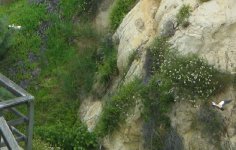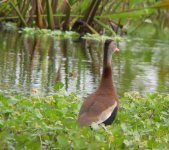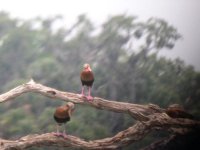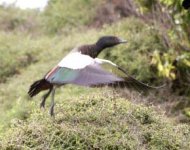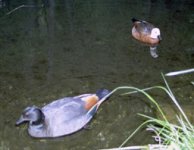I saw a pair of what I think are black-bellied whistling ducks in San Diego on May 27th at the Torrey Pines State Reserve. Photo is attached. Problem is the coloration on the back of the neck and wings looks different than in all of my books. Can anyone confirm? Could this be a hybrid? Thanks.
-
Welcome to BirdForum, the internet's largest birding community with thousands of members from all over the world. The forums are dedicated to wild birds, birding, binoculars and equipment and all that goes with it.
Please register for an account to take part in the discussions in the forum, post your pictures in the gallery and more.
You are using an out of date browser. It may not display this or other websites correctly.
You should upgrade or use an alternative browser.
You should upgrade or use an alternative browser.
Black-bellied Whistlinng Duck in San Diego? (1 Viewer)
- Thread starter moorsj
- Start date
More options
Who Replied?Katy Penland
Well-known member
Hi, moorsj! A warm welcome to you from all of us on staff here at BirdForum!
Can't see detail of the bird in the upper left well enough, but the lower right is interesting. Doesn't look like there's enough white in the wings to be a Black-bellied, which should extend from the greater through the primary coverts. The legs don't seem to extend beyond the tail as they should in that species, although it's hard to tell from the photo. I also don't see a red bill, although the juvies don't have that. When I first saw the wing shape and the lack of a red bill, I thought it might have been some kind of gannet or booby but that just raised even more problems with plumage and jizz.
I.e., I'm stumped. I'm sure someone else will be along who can nail this one for you.
I'm sure someone else will be along who can nail this one for you.
Can't see detail of the bird in the upper left well enough, but the lower right is interesting. Doesn't look like there's enough white in the wings to be a Black-bellied, which should extend from the greater through the primary coverts. The legs don't seem to extend beyond the tail as they should in that species, although it's hard to tell from the photo. I also don't see a red bill, although the juvies don't have that. When I first saw the wing shape and the lack of a red bill, I thought it might have been some kind of gannet or booby but that just raised even more problems with plumage and jizz.
I.e., I'm stumped.
Grousemore
Senior Member
Edward woodwood
Member
weird
they look dead like Aussie Shelducks
not bbwd though
Tim
ps nice pic Trev
are they not wary birds over your way?
they look dead like Aussie Shelducks
not bbwd though
Tim
ps nice pic Trev
are they not wary birds over your way?
Last edited:
Rasmus Boegh
BF member
Certainly not a Black-bellied WD. A few striking features (all of which are visible on the bird to the right, some on the bird to the left): White head, brown back, black tail & white-and-black(ish) pattern on wing. It doesn't seem like the white of the head extents down to near the shoulders & mantle and I can't see two white lines over the secondaries, thus excluding (I think...) Radja Shelduck. That basically leave one species, the Paradise Shelduck (T. variegara) from New Zealand. As far as I can see, eveything look just about right, the bird to the right probably being a female and the bird to the left (far away) probably being either an eclipse male or another female. The Paradise Shelduck is rather common in captivity. I think the head (at least on the bird to the right) do look too white for a Ruddy Shelduck, but from these photos I could be mistaken.
Last edited:
Grousemore
Senior Member
Tim Allwood said:ps nice pic Trev
are they not wary birds over your way?
Very wary, when they flush they fly around whistling for several minutes before returning to the same spot,
They eventually got fed up and sat in a tree!
I hasten to add it was not me flushing them,(fieldcraft rules!) but some prat with a new camera, despite the fact that we were the only two people around for miles.
Attachments
Last edited:
Edward woodwood
Member
magic Trevor!
look at the feet on em!
Tim
look at the feet on em!
Tim
Last edited:
Edward woodwood
Member
Rasmus you are spot on
that's the bird i am referring to as well
in Wildfowl (Madge and Burn) the Aussie Shelduck text is opposite the Paradise Shelduck pix - and vice versa...
I should look more carefully - or drink less
Tim
that's the bird i am referring to as well
in Wildfowl (Madge and Burn) the Aussie Shelduck text is opposite the Paradise Shelduck pix - and vice versa...
I should look more carefully - or drink less
Tim
Attached below are a couple of photos of Paradise Shelducks taken in New Zealand 5 years ago (SLR film camera and scanned into computer). The male and female are quite different, the female having a white head and being somewhat smaller than the male. Only got the male in flight, but perhaps this will help confirm the ID.
Attachments
Cory Laughlin
Member
Frank Todd will know
I worked with Frank Todd at Sea World San Diego who is on the short list of waterfowl experts. His Waterfowl of the World is one of the best works ever. I will send along your photo and see what he says!
I do think these birds are escapees from one of the gazillion bird collectors in California but wouldn't it be grand if they weren't?
Cheers, Cory
I worked with Frank Todd at Sea World San Diego who is on the short list of waterfowl experts. His Waterfowl of the World is one of the best works ever. I will send along your photo and see what he says!
I do think these birds are escapees from one of the gazillion bird collectors in California but wouldn't it be grand if they weren't?
Cheers, Cory
moorsj said:I saw a pair of what I think are black-bellied whistling ducks in San Diego on May 27th at the Torrey Pines State Reserve. Photo is attached. Problem is the coloration on the back of the neck and wings looks different than in all of my books. Can anyone confirm? Could this be a hybrid? Thanks.
Joern Lehmhus
Well-known member
My feeling was ruddy shellduck as the heads can look very white sometimes...
JANJ
Well-known member
Rasmus mentioned that the head on the right bird looks to white for a Ruddy, but doesn´t the back look to light for a female Paradise? They usually have a darker back compared to Ruddy, and also frequently look darker on body as well. When you blow the photo up a bit, it appears that the head isn´t snow white as in female Paradise, so to me it looks like a Ruddy.
JanJ
JanJ
Joern Lehmhus
Well-known member
I totally agree!!!-just looked at some photos in the web and I think it is the realtive light coloured back that made me have the gut feeling Ruddy and not Paradise shellduck...
Rasmus Boegh
BF member
JANJ said:Rasmus mentioned that the head on the right bird looks to white for a Ruddy, but doesn´t the back look to light for a female Paradise? They usually have a darker back compared to Ruddy, and also frequently look darker on body as well. When you blow the photo up a bit, it appears that the head isn´t snow white as in female Paradise, so to me it looks like a Ruddy.
JanJ
I was lucky enough to see quite a few Paradise Shelducks on my visit to the southern hemisphere a few months ago. The timing of this visit coincided with females both in breeding and a few in non-breeding plumage (several guides mention these two plumages, but few seem to show it - an illustration of a breeding female in flight can be found in Heather & Roberson's "Field Guide to the Birds of New Zealand"). In breeding the back is bright orange-rufous (only marginally darker than in Ruddy), while in non-breeding females are far darker, some almost appearing as dark as the male (but they retain the white head, of course). However, having said this, you may be right that the rump is too pale for Paradise. While it (according to my notes) is marginally paler than the upper back (the mantle area), what can be seen on the photos in this thread could very well be too much. On the other hand it seem rather pale for a Ruddy Shelduck as well, but we all know how variable the hue of this species is (I do not know if a similar variation can be found in the hue of the Paradise). Regarding the head - I'll have to repeat what I said in the previous post: "I think the head (at least on the bird to the right) do look too white for a Ruddy Shelduck, but from these photos I could be mistaken."
Last edited:
Users who are viewing this thread
Total: 2 (members: 0, guests: 2)




